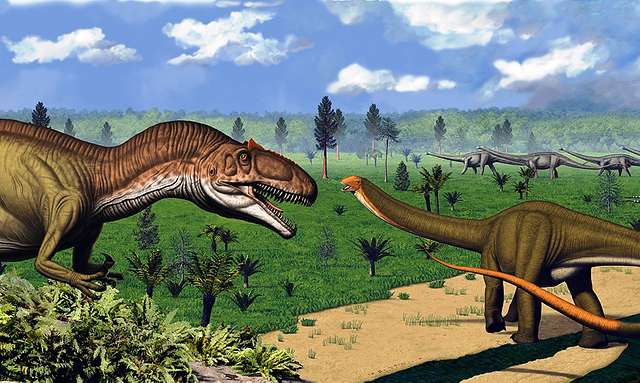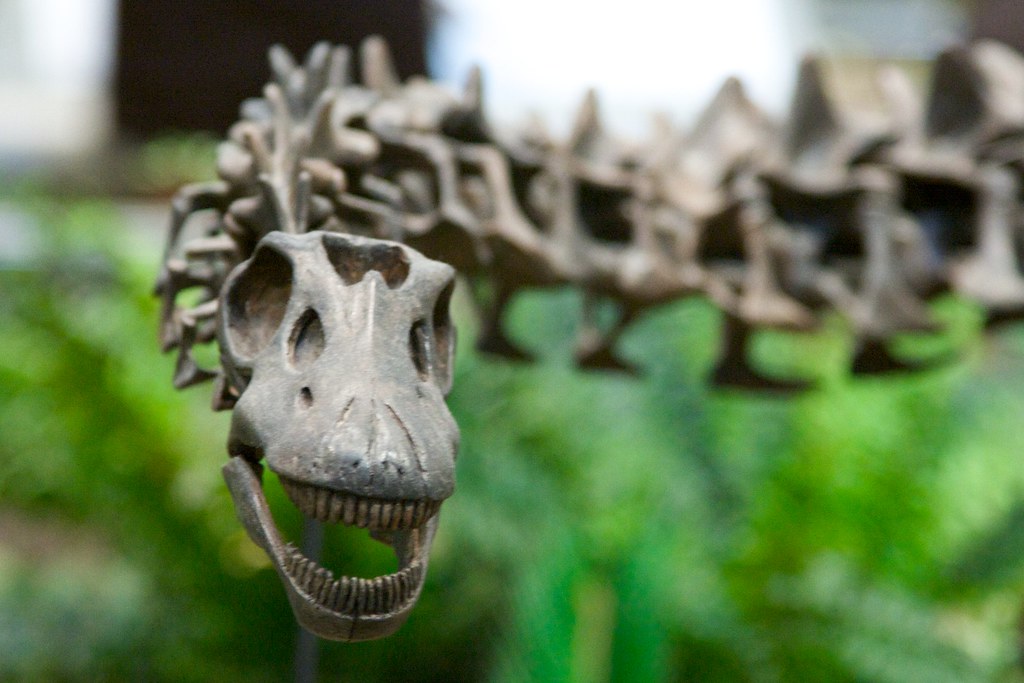The Apatosaurus was a sauropod dinosaur that once roamed the North American landscapes during the Late Jurassic period. This huge dinosaur is famous for its impressive size and distinctive anatomical features. Its discovery and subsequent classification have offered valuable insights into the complex ecosystems of Earth’s ancient past.
Discovery and Naming
In 1877, Arthur Lakes, a miner, and his colleague Henry C. Beckwith found the first Apatosaurus fossils in Morrison, Colorado. News of this discovery caught the attention of Othniel Charles Marsh, a renowned paleontologist from Yale University. Marsh was the first to describe and name Apatosaurus, with Apatosaurus ajax becoming the first known species.
The dinosaur’s name is derived from Greek and means ‘Deceptive Lizard’. The naming reflects the deceptive nature of its chevron bones which bore an unusual resemblance to those of Mosasaurs, an entirely different reptilian group.
The Apatosaurus broadened its family in 1916 when paleontologists described a second species, Apatosaurus louisae. William Holland, a distinguished paleontologist, made the discovery and named the species in honor of Louise Carnegie, the wife of philanthropist Andrew Carnegie. Found in Utah, the A. louisae fossils included a more complete skeleton and skull, unraveling more of the dinosaur’s morphology and sauropod evolution.
Apatosaurus Physical Characteristics
The Apatosaurus stands out for its substantial size and unique physical features. According to fossil records, the average length of an Apatosaurus ranged from approximately 21 to nearly 23 meters (69-75 feet). Estimates suggest that these dinosaurs typically weighed between a staggering 14.9 and 20.3 metric tons.
This genus, when compared with other sauropods like Diplodocus, had shorter but more robust cervical vertebrae. Apatosaurus’ leg bones are longer and sturdier, indicating a strong physical structure while holding the tail aloft during locomotion. The limbs of Apatosaurus featured a single claw on each forelimb and three on each hindlimb.
Paleontologists initially speculated that the skull was similar to that of Camarasaurus. However, more recently the consensus is that the Apatosaurus skull had more in common with that of Diplodocus.
The Apatosaurus’ build reflects not only its distinctive presence in the Late Jurassic landscape but also provides insights into the adaptations that supported its life as a large herbivore.

Habitat and Lifestyle
Apatosaurus lived during the Late Jurassic period, a period dating roughly 152 to 151 million years ago. The geological formations corresponding to the era suggest its habitat was a diverse and rich ecosystem. The Morrison Formation, extending across modern-day Colorado, Oklahoma, New Mexico, Wyoming, and Utah, served as the primary habitat for the Apatosaurus.
As a herbivorous creature, Apatosaurus was primarily a browser, likely feeding on a variety of vegetation. The Apatosaurus’ long neck suggests it could either feed from higher foliage or even graze closer to the ground.
In terms of mobility, Apatosaurus’ robust leg bones indicate a powerful yet deliberate form of movement. Experts believe that the tail’s structure could serve as a whip-like defense mechanism and even possibly as a sensory organ. The combined anatomical features of Apatosaurus paint a picture of a slow-moving giant, pacing surefooted through its environment.

Skull Confusion and Clarification
The identification of the Apatosaurus skull was historically shrouded in confusion. Initially, experts believed that the skull of Apatosaurus resembled that of Camarasaurus, a misconception that persisted into the early 20th century. This error was so ingrained that several mounted Apatosaurus skeletons were inaccurately displayed with Camarasaurus skulls.
This confusion was finally resolved in 1916, with the discovery of the holotype of A. louisae. Holland found a complete skull just meters away from the neck, revolutionizing how we perceived the appearance of the Apatosaurus. Contrary to earlier beliefs, the skull was more akin to that of Diplodocus, marked by a smaller size relative to the body and a distinctly different shape.
The clarification of the Apatosaurus skull morphology was a pivotal moment in paleontology. It not only corrected a long-standing error but also deepened our understanding of sauropod diversity and evolution.

Apatosaurus versus Brontosaurus
The Apatosaurus and Brontosaurus genera have been at the center of a long-standing debate in paleontology. The Brontosaurus saga began in the 1870s in the USA, where the first evidence of this giant reptile emerged. Early paleontologists initially thought Brontosaurus was distinct from its close relative, Apatosaurus.
However, in 1903 Elmer Riggs claimed that Brontosaurus is sufficiently similar to Apatosaurus to be considered the same genus, having the debate take a significant turn. Consequently, experts at the time largely cast aside Brontosaurus, though it remained a popular name in public discourse.
For over a century, Brontosaurus lingered in the public imagination but vanished from scientific texts. However, a comprehensive study in 2015 would resurrect the famous dinosaur. This research was based on an extensive morphological analysis and suggested that Brontosaurus should be reinstated as a separate genus. The study highlighted distinct differences between the two, such as in the neck’s width and strength.
Despite these findings, the scientific community remains divided, with some paleontologists still supporting the separation and others advocating for a unified classification.

Conclusion
More than just a fascinating subject for paleontologists, the Apatosaurus offers a window into the Late Jurassic ecosystem. Its immense size, distinctive physical features, and herbivorous lifestyle provide insights into the dynamics of prehistoric life.






